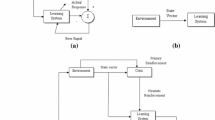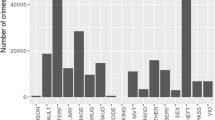Abstract
One of the main concerns for countries has been always crime activities. In recent years, with the development of data collection and analysis techniques, a massive number of data-related studies have been performed to analyze crime data. Studying indirect features is important yet challenging task. In this work we are using machine learning (ML) techniques to try to identify the top variables affecting crime rates in different US communities. The data used in this work was collected from the Bureau of the Census and Bureau of Justice Statistics. Out of the 125 variables collected in this data we will try to identify the top factors that correlate with higher crime rates either in a positive or a negative way. The analysis in this paper was done using the Lasso Regression technique provided in the Python library Scikit-learn
Access this chapter
Tax calculation will be finalised at checkout
Purchases are for personal use only
Similar content being viewed by others
References
Melossi, D.: Controlling Crime, Controlling Society: Thinking about Crime in Europe and America. 1st edn. Polity, (2008)
Herath, H.M.M.I.S.B., Dinalankara, D.M.R.: Envestigator: AI-based crime analysis and prediction platform. In: Proceedings of Peradeniya University International Research sessions, vol. 23, no. 508, p. 525 (2021)
Baumgartner, K.C., Ferrari, S., Salfati, C.G.: Bayesian networkmodeling of offender behavior for criminal profiling. In: Proceedings of the 44th IEEE Conference on Decision and Control (CDC-ECC), pp. 2702–2709 (2005)
Linning, S.J., Andresen, M.A., Brantingham, P.J.: Crime seasonality: examining the temporal fluctuations of property crime in cities with varying climates. Int. J. Offender Ther. Comp. Criminol. 61(16), 1866–1891 (2017)
Almanie, T., Mirza, R., Lor, E.: Crime prediction based on crime types and using spatial and temporal criminal hotspots. arXiv preprint arXiv:1508.02050 (2015)
Nguyen, T.T., Hatua, A., Sung, A.H.: Building a learning machine classifier with inadequate data for crime prediction. J. Adv. Inf. Technol. 8(2) (2017)
Ghosh, D., Chun, S., Shafiq, B., Adam, N.R.: Big data-based smart city platform: real-time crime analysis. In: Proceedings of the 17th International DigitalGovernment Research Conference on Digital Government Research, pp. 58–66. ACM (2016)
McClendon, L., Meghanathan, N.: Using machine learning algorithms to analyze crime data. Mach. Learn. Appl. Int. J. (MLAIJ) 2(1), 1–12 (2015)
Phillips, P., Lee, I.: Mining top-k and bottom-k correlative crime patterns through graph representations. In: 2009 IEEE International Conference on Intelligence and Security Informatics, pp. 25−30 (2009). https://doi.org/10.1109/ISI.2009.5137266
Asuncion, A., Newman, D.J.: UCI Machine Learning Repository, School of Information and Computer Science, University of California, Irvine, CA (2007). https://www.archive.ics.uci.edu/ml/datasets/Communities+and+Crime
Kumar, D.: A Complete understanding of LASSO Regression. The Great Learning (26 December 2021). https://www.mygreatlearning.com/blog/understanding-of-lasso-regression/#:~:text=Lasso%20regression%20is%20a%20regularization,i.e.%20models%20with%20fewer%20parameters)
Kuhn, M., Johnson, K.: Feature Engineering and Selection: A Practical Approach for Predictive Models, 1st edn. CRC Press, New York (2019)
Author information
Authors and Affiliations
Corresponding author
Editor information
Editors and Affiliations
Rights and permissions
Copyright information
© 2023 The Author(s), under exclusive license to Springer Nature Switzerland AG
About this paper
Cite this paper
Samara, K. (2023). Using Machine Learning to Identify Top Antecedents Affecting Crime in US Communities. In: Arai, K. (eds) Advances in Information and Communication. FICC 2023. Lecture Notes in Networks and Systems, vol 652. Springer, Cham. https://doi.org/10.1007/978-3-031-28073-3_7
Download citation
DOI: https://doi.org/10.1007/978-3-031-28073-3_7
Published:
Publisher Name: Springer, Cham
Print ISBN: 978-3-031-28072-6
Online ISBN: 978-3-031-28073-3
eBook Packages: Intelligent Technologies and RoboticsIntelligent Technologies and Robotics (R0)




